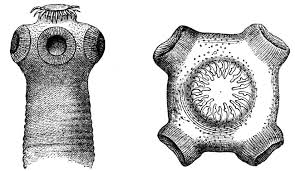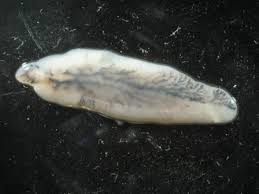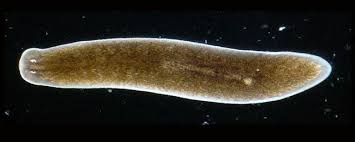The animals of this phylum have a dorso-ventrally flatted body. Their upper (dorsal) and lower (ventral) body surfaces are flat and that’s why they are commonly called flatworm.


General characteristic Features of platyhelminthes:-
(1) Habit and habitat:- These are mostly endoparasites as they live inside the body of other animals (called hosts); some flatworms are free living. These free-living flatworms are mainly aquatic (marine or fresh water). Some form are terrestrial also. Dugesia (Planaria) is a fresh water flatworm which lives in the freshwater ponds, lakes and streams.
(2) Body symmetry:– These are bilaterally symmetrical animals as their body can be divided into indentical left and right halves by a vertical plane passing through the central axis of the body.
(3) Level of organization:– They are the first animals to have reached the organ level of organization. Body cells aggregated to form tissues and tissues organized to form organs. Some organs systems are also present in them.
(4) Germ layers:- platyhelminthes are the triploblastic animals,their body structures are derived from three embryonic germ layers ectoderm, mesoderm, and endoderm.
(5) Coelom:- Although they are the triploblastic animals bearing mesoderm but coelom (e.g mesoderm-lined body cavity) is lacking in them. Hence, flatworm are the acoelomate animals.
(6) Body form:- Flatworms have a dorso-ventrally flattened body.
(7) Exoskeleton and Endoskeleton are completely absent. However, hooks, spines, suckers (in parasitic form) teeth or thorns may be present which act as adhesive organs.
(8) The space between the body wall, alimentary canal and other organs is filled with a peculiar connective tissue called the parenchyma. It help in transportation of food materials.
(9) Respiratory and circulatory system are absent.
(10) Digestive tract:– Digestive system in platyhelminthes has only a single opening to the outside of the body, that serves both as mouth and anus and hence it is incomplete. Digestive tract is absent in tapeworm.
(11) Parasitic flatworm:- They have special adaptations in their body to obtain nutrition from their hosts which are discussed in the following topic.
Parasitic adaptations:-
(i) Hooks:- Hooks are the adhesive structures which help the worm to attached to the internal body layers of host. Hence hooks act as the organs of attachment, present in Taenia.
(ii) Suckers:- These help in adhesion as well as ingestion (of food). Suckers act as the suctorial organs which help in sucking the food from the body of host. Present in Taenia as well as Fasciola.
(iii) Direct absorption of food through body surface:- As they have a flat body so some of them are able to absorb the nutrients directly through body surface. They are the endoparasites which live inside other living animals and the soluble food materials directly diffuse through their body surface. This is seen in Taenia.
(iv) Thick tegument:- The body is externally covered with a thick tegument, a protective layer that protects the parasitic worms from the digestive juices of host.

(12) Excretion and osmoregulation:– Flame cells are the specialized cells of platyhelminthes which help in the excretion as well as osmoregulation.
(13) Nervous system is primitive:- The main nervous system consists of a pair of cerebral ganglia or brain and one to three pairs of longitudinal nerve cords connected to each other b transverse commissures. This type of nervous system is called ladder like nervous system.
(14) Reproduction:– The flatworms are hermaphrodite (monoecious) except Schistosoma. They mainly reproduce sexually by producing sperms and ova. However some forms reproduce asexually also. For e.g. Planaria. It reproduces by transverse binary fission.
(15) Fertilisation:- The fertilization is internal in flatworm.
(16) Development:– It is usually indirect with a complicated life cycle involving many larval stages and more than one host.
(17) Regeneration:- The ability of an organism to replace its lost or damaged parts or the ability to develop a complete and normal individual from a part of the body is called regeneration. Some flatworms possess a tremendous power of regeneration. If these animals are cut across into two or three or more parts, each cut part regenerates into a complete and normal individual e.g. Planaria.It shows a high regeneration power.
Example: Taenia (Tapeworm), Fasciola (liver fluke)
Phylum-platyhelminthes
Fasciola – The Liver Fluke
- It is digenetic endoparasite found in the bile duct of the liver of sheep and goat which serve as primary host and larval stages in an intermediate (secondary) host called Limnaea and Planorbis (snails).
- In primary host i.e., sheep it causes liver rot.
- Respiration takes place in the absence of oxygen. The fluke is hermaphrodite but there is cross fertilization.
- Life cycle involves many larval stages such as miracidium, sporocyst, redia, cercria, and metacercaria.
- Fasciola is supposed to show the phenomenon of Germ cells in the sporocysts and rediae are direct descendants of the zygote. These germ cells multiply mitotically and produce subsequent larval stages within the sporocysts and rediae. This process of reproduction in the sporocysts and rediae is called polyembryony.